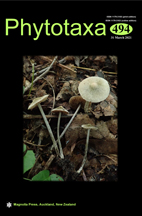Abstract
Neofusicoccum species are endophytes, saprobes and opportunistic pathogens of many economic and ornamental plants. There are few reports of Neofusicoccum species are available to be associated with orchids worldwide. In this study, five endophytic Neofusicoccum strains were isolated from Dendrobium orchid leaves and stems in southwestern China and northern Thailand. Morphological characteristics and phylogenetic analysis of the combined partial nuclear rDNA internal transcribed spacer (ITS), partial RNA polymerase Ⅱ second largest subunit (RPB2), part of the translation elongation factor 1 alpha (EF-1α) and beta-tubulin (TUB2) dataset revealed that these isolates belong to two species Neofusicoccum occulatum and N. parvum. This is the first record of Neofusicoccum occulatum associated with Dendrobium chrysanthum while N. parvum associated with D. harveyanum and D. moschatum.

